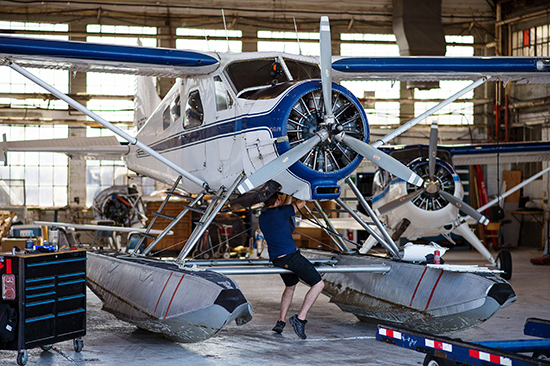这种飞机可能颠覆运输业

|
从科幻角度来说,德哈维兰加拿大公司(de Havilland Canada)的DHC-2海狸飞机,一点都没有未来感:矮壮的机翼、结实的机身和两个肥大的浮筒。这款飞机在1947年首飞。 不过,当一架海狸飞机在本周二早晨从温哥华港起飞时,许多航空业内人士却称,这就是商业航空的未来。因为史上首次,一架载有付费乘客的飞机使用电动马达起飞了。 初创公司MagniX的Magni500电动马达为这架海狸飞机提供动力,该飞机隶属于总部设在温哥华的加拿大港湾航空公司(Harbour Air)。这家小型航空公司的主管格雷格·麦克道加尔驾驶这架飞机开始了在水面上空的短暂航程,然后他让飞机平稳地在港口降落,并将飞机缓缓开到码头,在那里,一群观看此次飞行的人们欢呼雀跃。 有许多装了电动马达的飞机曾经试飞过,但港湾航空是第一家将业务押注在电动马达上的航空公司。它希望监管者能够在两年内认可这架改型了的飞机,并在2022年开始商业飞行。 多年来,航空业一直在讨论电动飞机的商业飞行是否可行。周二的试飞似乎在说“这是真实可行的,”MagniX的首席执行官罗伊·甘查尔斯基告诉《财富》杂志,“这是一家飞着自己造的飞机的航空公司。” 港湾航空是一家小型航空公司,拥有42架水上飞机,飞行线路环绕不列颠哥伦比亚省的乔治海峡。 MagniX还在与其他航空公司会谈,尽管依照保密协议,甘查尔斯基拒绝透露有几家。“毫不疑问,有很多会谈在进行中。”他说。 改装飞机,是MagniX的双管齐下战略的一部分,以便在日益拥挤的电动马达市场确立领导地位。公司三款较小的Magni250马达,将安装在位于以色列的Eviation公司的爱丽丝飞机上,这款飞机专为电动马达动力而设计,可以容纳9名乘客。 Eviation和MagniX的所有者,均为新加坡的克莱蒙特集团(Clermont Group),而该集团的所有者理查德·钱德勒,一向以长期投资而知名。甘查尔斯基说,克莱蒙特为MagniX提供足量资金,使其免于依赖不确定的数轮融资。 据美国证券交易委员会的文档显示,今年1月,克莱蒙特向Eviation投了7600万美元,获得70%的股权。甘查尔斯基在11月被任命为Eviation的董事会主席。 今年6月在巴黎空展上,总部位于马萨诸塞州的海角航空(Cape Air)下了首批爱丽丝飞机的订单,预计将于2020年首飞,并在两年后进行商业飞行。这款时髦的飞机预计能够用电动动力飞行近600英里,与之相比经改装的海狸航程只有100英里。 但一码归一码,电池组的能量远少于航空燃油,航空燃油携带的能量是电池组的40倍,这意味着港湾航空的海狸飞机上,只要有空间的地方都得装电池,甘查尔斯基说。 考虑到电池的低能量密度,全世界范围要见到全电动的地区性和大型商业航班,可能还需要数十年,这是航空咨询师本琼·费赫姆为网站“利厄姆新闻与分析”(Leeham News and Analysis)撰文时提到的,这家新的网站是由西雅图区域的航空咨询公司利厄姆(Leeham)运营的。 混合动力航班可能会先于全电动航班普及。空客(Airbus)就在考虑将单过道机型A320改造成混合动力飞机。这家欧洲航空公司尚处于考虑未来飞机的初级概念阶段,而未来的飞机预计将在2030年中期全面铺开。空客的竞争对手波音(Boeing),也在考虑混合动力飞机。波音收购了Zunum Aero公司,这是一家位于西雅图的开发小型客机的初创企业。 短途的混合动力机型,比如Zunum的ZA10,以及全电动机型比如爱丽丝,都承诺能够大幅削减运营成本。甘查尔斯基预计,这种航班的成本要比使用化石燃料的航班成本低60%到80%。 最受欢迎的短途飞机塞斯纳卡拉万(Cessna Caravan),飞行100英里,载客9人,需要耗费价值超过300美元的燃油。“一架电动卡拉万,耗电成本大概是6到10美元。”甘查尔斯基说。MagniX公司目前正在华盛顿州中部的摩西莱克试飞一架经改装的卡拉万。 电动马达与内燃式发动机相比,维护成本也更低,内燃式发动机有很多的运动部件,工作环境也极端得多。一架全电动飞机的启用,其初期成本与传统飞机相比可能更高。操作者需要更换电池。更换的频率是数年,要视飞行的频率而定,费赫姆说。 即便如此,甘查尔斯基仍然预计,到2025年改装为电动动力的飞机将开始在现有的飞行路线上取代化石燃料飞机。除了更低的运营和维护成本,他还说,到2035年“大多数电动飞机的飞行线路,今天还尚未存在”。 使用小型电动飞机的航空公司将意识到,他们“不再需要美国联邦运输安全管理局(TSA)的监管,不需要登机口。他们只需要一块降落区域,可以充电。”他说。 费赫姆则不那么乐观,他写道,这个行业还处于“预期膨胀的顶峰”这一初级阶段。(财富中文网) 译者:宣峰 |
For a sci-fi airplane, the de Havilland Canada DHC-2 Beaver looks nothing like the future: stubby wings, a burly fuselage and two fat pontoons. It first flew in 1947. Nonetheless, when a Beaver lifted off from Vancouver Harbour Tuesday morning, it signaled what many aerospace industry insiders say is commercial aviation’s future. For the first time, an aircraft that carries paying passengers took off with an electric motor. Startup magniX’s Magni500 electric motor powered the Vancouver-based Harbour Air’s Beaver into the air. The small airline’s chief executive, Greg McDougall, piloted the aircraft during the brief flight over the water, followed by a gentle landing in the harbor. He taxied the plane back to a dock, where a small crowd watching the event cheered. Plenty of electric-powered aircraft have flown, but Harbour Air is the first airline that is betting its business on electric motors. The airline expects regulators to certify its retrofitted aircraft in about two years, with commercial flights beginning in 2022. For years, the aerospace industry has been talking about whether electric-powered commercial air travel is viable. Tuesday’s flight declared “this is real,” MagniX CEO Roei Ganzarski tells Fortune. “This is an airline flying their own aircraft.” Harbour Air is a small airline with 42 small seaplanes flying routes around British Columbia’s Strait of George. MagniX is in talks with other airlines, although Ganzarski declined to say how many, citing confidentiality agreements. “There are definitely a lot of conversations going on,” he says. Retrofitting aircraft is one part of magniX’s two-prong strategy to establish itself as a leader in the increasingly crowded electric motor sector. Three of the company’s smaller Magni250 motors will power Israel-based Eviation’s Alice aircraft, which is specifically designed to be electric-powered and can fit nine passengers. Both Eviation and magniX are owned by Singapore-based Clermont Group, whose owner, Richard Chandler, has a reputation for making long-term investments. Clermont is fully bankrolling magniX, saving the motor maker from depending on uncertain fundraising cycles, Ganzarski says. Clermont put $76 million in Eviation Aircraft in January for a 70% stake, according to a U.S. Securities and Exchange Commission filing. Ganzarski was named chairman of Eviation’s board in November. At the Paris Air Show in June, Massachusetts-based Cape Air placed the first firm order for the Alice, which is expected to first fly in 2020 and to enter service two years later. The sleek aircraft is expected to have a range of nearly 600 miles under electric power compared to the retrofitted Beaver’s 100-mile range. Pound for pound, batteries pack far less energy than aviation fuel, which has as much as 40 times greater energy . That means batteries are stuffed everywhere there is space in Harbour Air’s Beavers, Ganzarski said. Given batteries’ low energy density it likely will be decades before the world sees all-electric regional and large commercial jetliners, aerospace consultant Bjorn Fehrm writes for Leeham News and Analysis, a news site run by the Seattle-area aerospace consulting firm Leeham. Hybrid airliners likely will precede all-electric jetliners. Airbus is considering offering a hybrid option of the successor to its single-aisle A320. The European airplane maker is early in the concept phase for that future aircraft, which is not expected to roll out until the mid-2030s. Airbus’ rival, Boeing, is pursuing hybrid aircraft as well. It acquired Zunum Aero, a Seattle-area startup developing a small passenger plane. In the meantime, short-haul hybrid aircraft, such as Zunum’s ZA10, and all-electric ones like the Alice promise to slash operating costs. Ganzarski expects it to be 60 to 80% cheaper to operate than fossil-fuel aircraft. A 100-mile flight in the nine-passenger Cessna Caravan, one of the most popular short-haul aircraft, costs more than $300 in fuel. “In an electric Caravan, you will spend $6 to $12 on electricity” to charge its batteries, he said. MagniX is currently flight-testing a retrofitted Caravan at Moses Lake in central Washington. Maintenance costs will be lower as well for electric motors compared to internal combustion engines, which have more moving parts creating much more extreme conditions. An all-electric airplane likely will have higher upfront costs compared to traditional planes. Operators will have to replace batteries. That could be as often as every few years, depending on how often the planes fly, according to Fehrm. Even so, Ganzarski expects by 2025 retrofitted electric aircraft will start replacing fossil-fuel planes on existing routes. Given the lower operating and maintenance costs, he says, “the majority of electric aircraft will be flying routes that today don’t exist” by 2035. Airlines using small electric planes will realize they “don’t need TSA, they don’t need gates. They just need a landing strip with charging infrastructure,” he said. Fehrm is not so optimistic. He writes that the industry is still in the initial “peak of inflated expectations.” |













